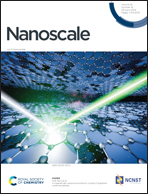Electrochemical control of the morphological evolution of PEDOT on a Ni–Co(OH)2/carbon cloth surface to modulate the performance of wearable H2O2 sensors†
Abstract
The slow redox rate of hydrogen peroxide (H2O2) in neutral environments makes the H2O2 sensor inadequate for the detection of low levels of signalling molecules. The aim of this study is to fabricate a flexible sensing electrode by hydrothermally loading micro-nanometer Ni and Co(OH)2 on carbon cloth (CC) and electrochemically depositing poly(3,4-ethylenedioxythiophene) (PEDOT) on the surface of the electrode. The sensor presented high sensitivity (10.43 mA mM−1 cm−2), a wide detection range (0.033–120.848 mM), a low detection limit (0.92 nM), high stability, and excellent anti-interference performance in neutral solutions. Ni–Co(OH)2 provides abundant active sites while CC solves their agglomeration phenomenon and conductivity. The PEDOT film offers heightened conductivity, hydrophilicity, interfacial stability, and an electrochemically active surface area (ECSA). The side area of the chrysanthemum petal like PEDOT is 39 ± 7 times the bottom area, and PEDOT increases the ECSA of the composite to six times that of CC. Electrochemical precise control of PEDOT morphology to improve sensor performance provides a new strategy for the application of PEDOT in sensors.

- This article is part of the themed collection: 2025 Chinese New Year Collection


 Please wait while we load your content...
Please wait while we load your content...